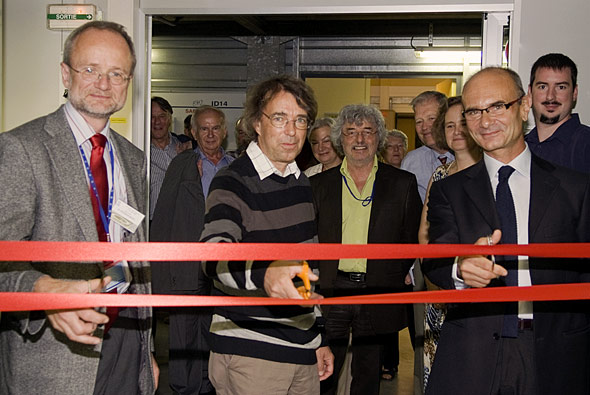- Home
- News
- General News
- New Bio-SAXS beamline...
New Bio-SAXS beamline inaugurated
24-06-2009
On 15 June 2009, guests from the ESRF Council joined staff from the ESRF and EMBL for the inauguration of the new structural biology small-angle scattering beamline ID14-3.
Scientists trying to find the structure of proteins now have an extra string to their bow with the new ID14-3 SAXS beamline. Small-angle X-ray scattering (SAXS) allows the study of the shapes of proteins in solution - particularly useful for structural studies of proteins that fail to crystallise, making normal crystallographic techniques impossible. For those proteins that do crystallise, SAXS can provide complementary data to verify that the protein’s structure in crystallo is representative of its structure in solution. This ability to take measurements in solution makes SAXS useful for functional studies - experiments can replicate physiological conditions, include the presence of ligands or involve changes in pH and temperature.
The beamline is the fruit of a successful collaboration between the ESRF and the EMBL Grenoble outstation, and is run by one scientist from each – Petra Pernot and Adam Round respectively. To represent this joint effort, the beamline was inaugurated with two ribbons, which were cut by three representatives: R. Feidenhans’l (Chairman of the ESRF Council), S. Cusack (Head of EMBL Grenoble) and F. Sette (Director General of the ESRF). The final addition to the beamline was a robotic sample changer, demonstrated for those attending the inauguration. Adam Round explained that this was a particularly challenging beamline to automate, because of the many stages involved in preparing an experiment. However, through a trilateral collaboration between the ESRF and both Grenoble and Hamburg EMBL outstations, equipment has been developed which, it is hoped, will enable higher throughput and increase reliability.
 |
|
Figure 1. Cutting the ribbons: From left to right, R. Feidenhans’l (Chairman of the ESRF Council), S. Cusack (Head of EMBL Grenoble) and F. Sette (Director General of the ESRF). |
Although the inauguration of beamline ID14-3 marks the end of more than one year of construction and commissioning, the first experiments started in November 2008 – and Adam Round and Petra Pernot are delighted with the initial results. “ID14-3 has provided valuable data”, said Pernot proudly, “and some manuscripts using these data are already submitted for publication”.
This SAXS beamline complements existing facilities for small-angle neutron scattering (SANS) at the Institut Laue-Langevin (ILL). It is intended to develop a combined SAXS/SANS platform, whereby external users of both the ESRF and ILL will have access to an unprecedented range of instruments for the study of protein structure and function. The combined SAXS/SANS platform aims to simplify access for scientists who require both neutron and X-ray techniques during their visit to the common site.
Top image: SAXS scattering pattern collected on TMV (tabacco mosaic virus) at ID14-3, courtesy of L. Wiegart.



